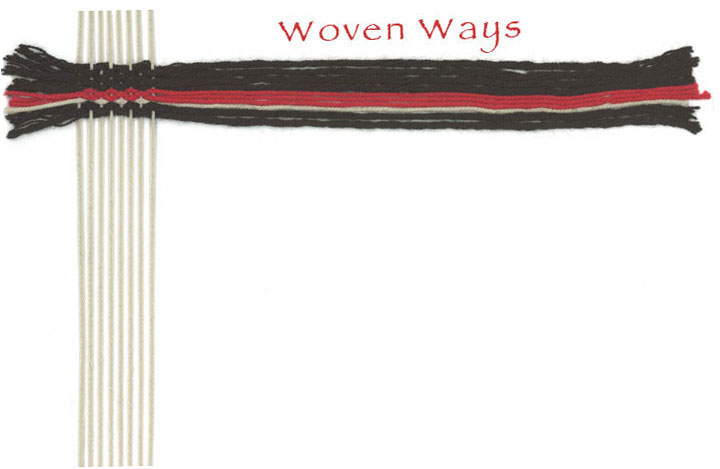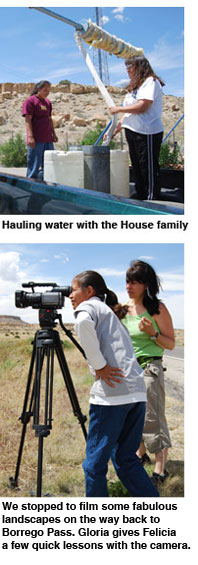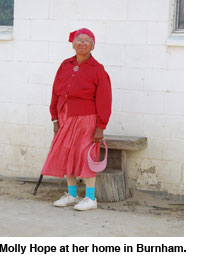

|
Since the fall of 2004, when I first met TahNibaa Naataanii and learned about the annual pilgrimage she makes to herd her sheep up to the summer grazing lands high atop the Chuska Mountains, I’ve wondered if I’d ever get the chance to accompany her on the journey. When I spoke with TahNibaa in late May and learned that the date for this year’s trip was set for June 2, our editor Gloria LaMorte and I jumped at the chance to head out to the reservation and film the event. At the time, we were knee deep in editing. It was becoming clear to us in the process that there were several small pieces of this important story that we had yet to capture on film. Within a couple of days Gloria had developed our shot list while I booked our flights and contacted 4 of the 5 families featured in Woven Ways. We quickly solidified plans for what would be our final filming trip. One of our goals for this trip was to capture footage that could visually represent TahNibaa’s dedication to her herd, and the vital role the sheep play in her culture and livelihood as a weaver. The trip up the Chuskas felt like the perfect setting. Somehow, over the course of the past 2 1/2 years, I had romanticized the trip as a beautiful cultural event (which it is), rather than a grueling 10 mile vertical climb!
The payoff was worth every step – the footage we got is stunning! I was struck by the rich colors we saw along the way and captured on film – varying shades of brown and white in the sheep and goats, against the backdrop of the sage green vegetation in the valley and foothills leading up to the mountains. The landscape changed to sun-bleached rocks and highland evergreens as the climb got increasingly steeper. A couple of ample spring storms broke the six year drought Another missing piece of the Woven Ways story was footage that illustrated the daily hardships that result from a lack of electricity and running water in many Navajo homes. We spent a day with our dear friends Bernice House and her daughters Alisha and Felicia, filming the biweekly water hauling routine they go through for grandmother, Dorothy Tolth. The shoot began with a drive out to Dorothy’s home in Borrego Pass. After loading up water containers of varying sizes we headed some 24 miles northwest to the public water pumping station in Crownpoint. The water in Crownpoint is pristine, but that won’t last long (7 years or so) if Hydro Resources Incorporated (HRI) has its way and begins a massive uranium mining project in town. HRI will inject contaminants into the aquifer that provides drinking water to some 25,000 Navajos, including the House family. The day grew hotter and hotter, so the girls welcomed the inevitable splashing that came with the job. Man, do those jugs and barrels become difficult to move when they’re full! Once they were secured in the truck we turned back towards Borrego Pass, completing a 48 mile round trip. Getting the containers off the truck and into the house was the most difficult part of the chore. The girls don’t complain – water is a blessing here, and they’re happy to have it. We finished off our visit with the family by visiting close relatives a few miles down the road. Alicia and Felicia piled out of the truck and raced around back to the trampoline. There they joined Cousin Nicole and her two little brothers jumping and singing "Ring around the Rosy" until it made me dizzy just to watch them. Their laughter was so contagious that at one point, they coaxed Gloria to jump into the fun.
In the last Woven Ways Journal Notes I wrote about the courageous act of resistance that Sarah White and fellow activists carried out by setting up an encampment this past winter in Burnham, at the site of the proposed Desert Rock Power Plant. If built, the plant will put an additional 13.7 million tons of carbon dioxide to the air each year. Sarah took us miles and miles down dirt roads to ground zero in Burnham. There we met elder Molly Hope and others whose lives will be profoundly impacted, not only by the power plant, but also by drag-line coal mining that is displacing dozens of Navajo families from the their ancestral homelands. We’ve long referred to Sarah as a "reluctant" activist. She didn’t go looking for the fight to keep the Desert Rock Power Plant from ever coming to be, and she didn’t ask to lead the charge against it. Her own battle with asthma and the threat that the plant poses for her fellow Navajo and future generations have fueled her involvement. On this trip we witnessed Sarah go from "reluctant activist" to "leader of the resistance." With warmest regards, |
|||||
|
CONTACT Woven Ways © 2007 |
|||||
 |
|||||
 |
|||||